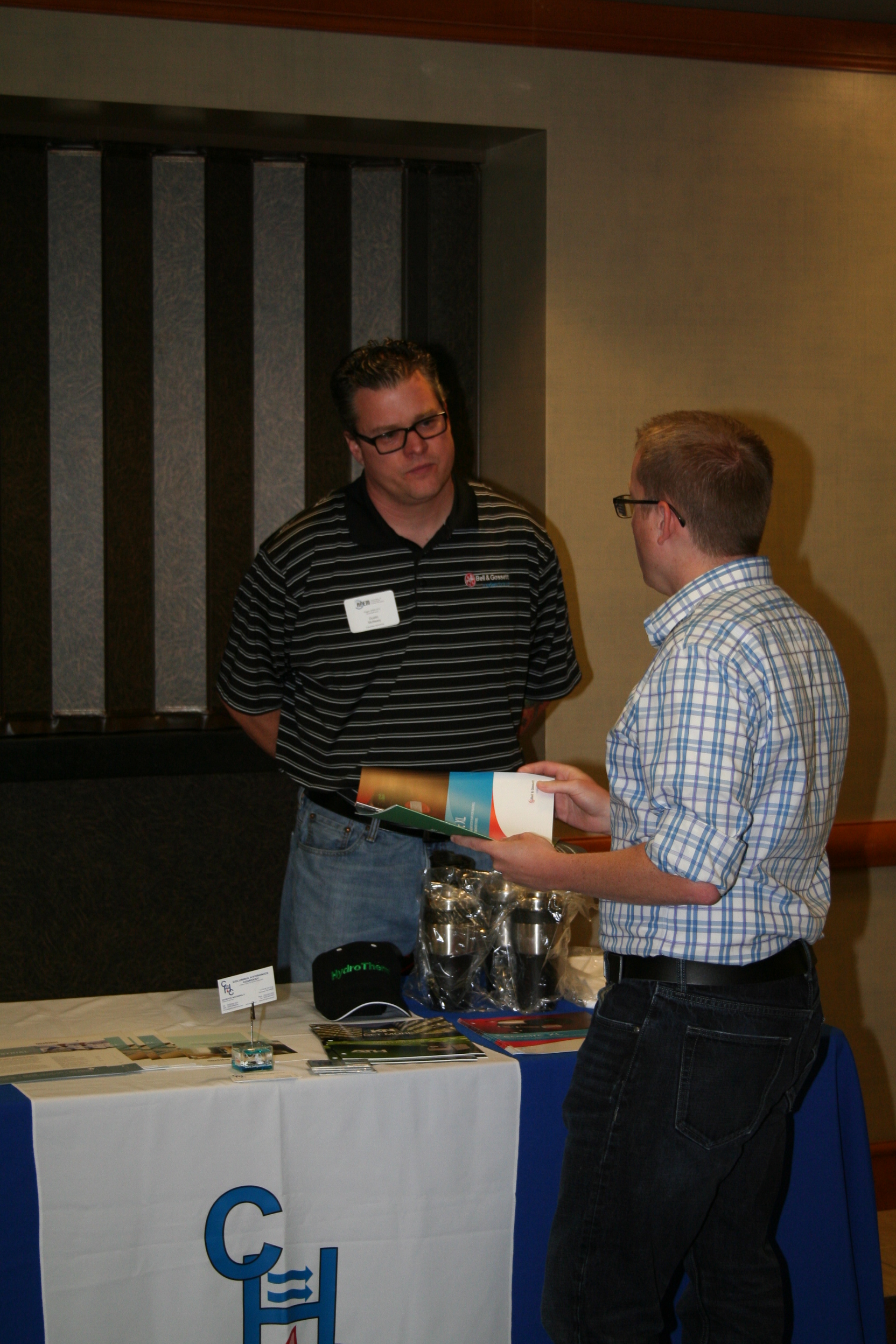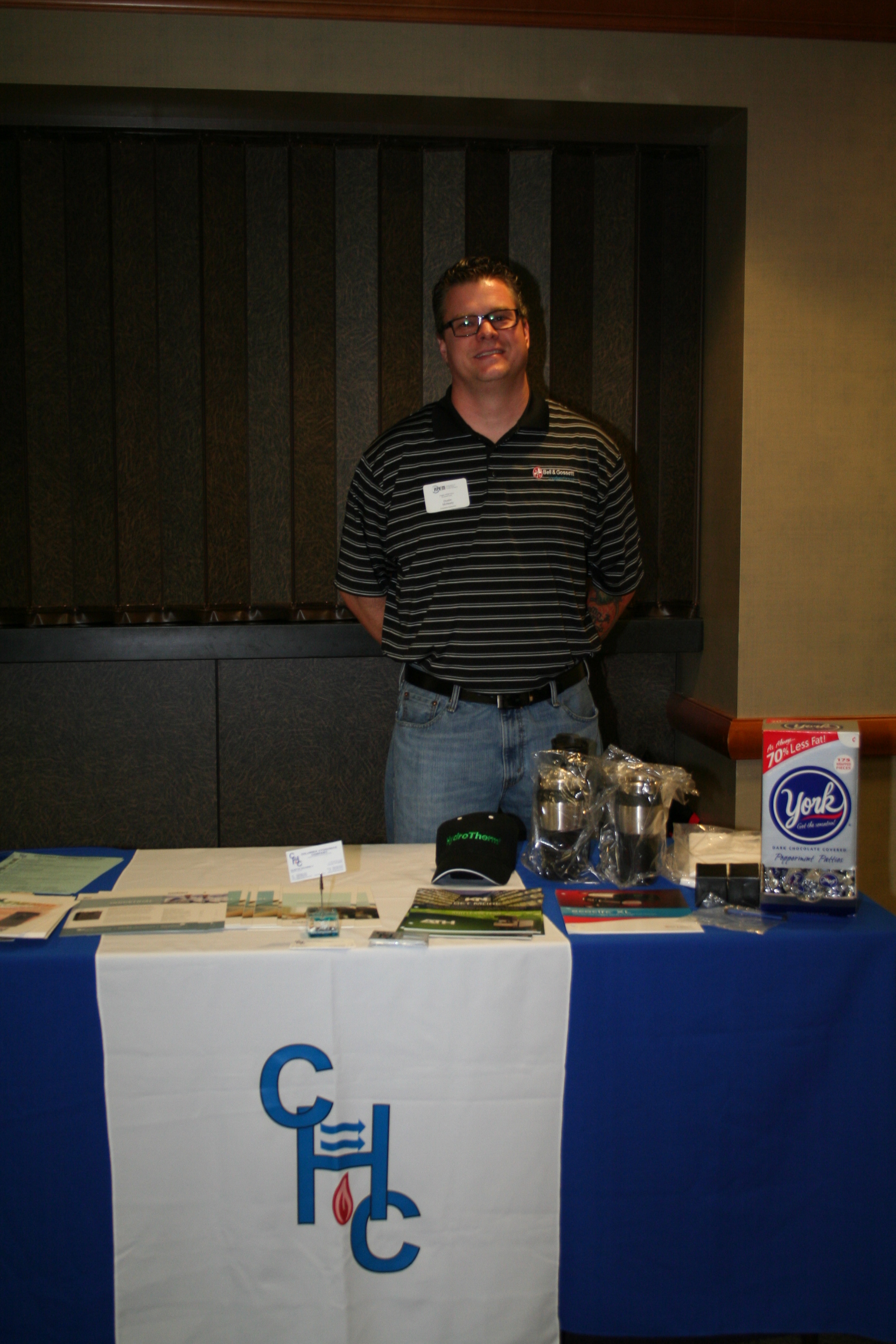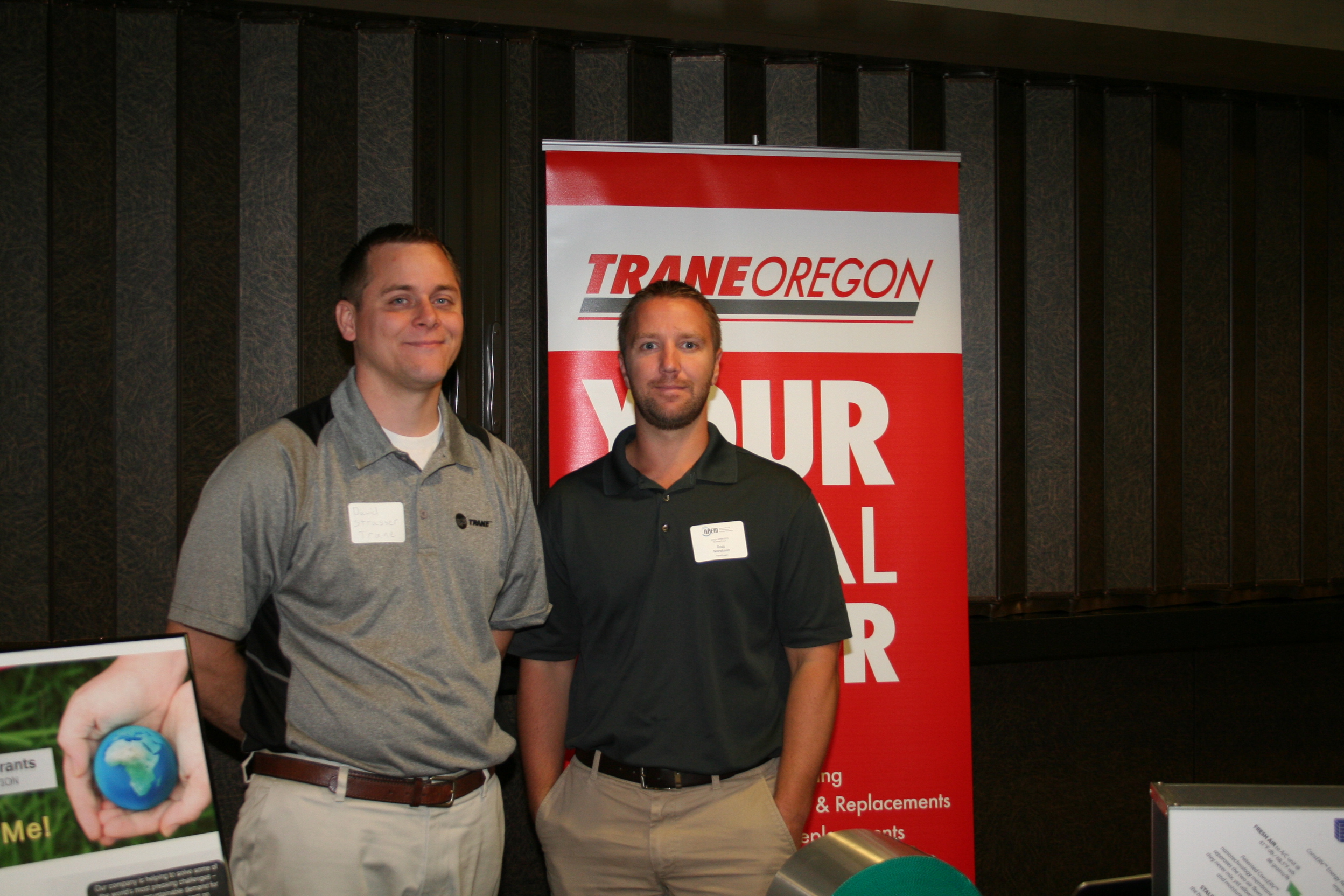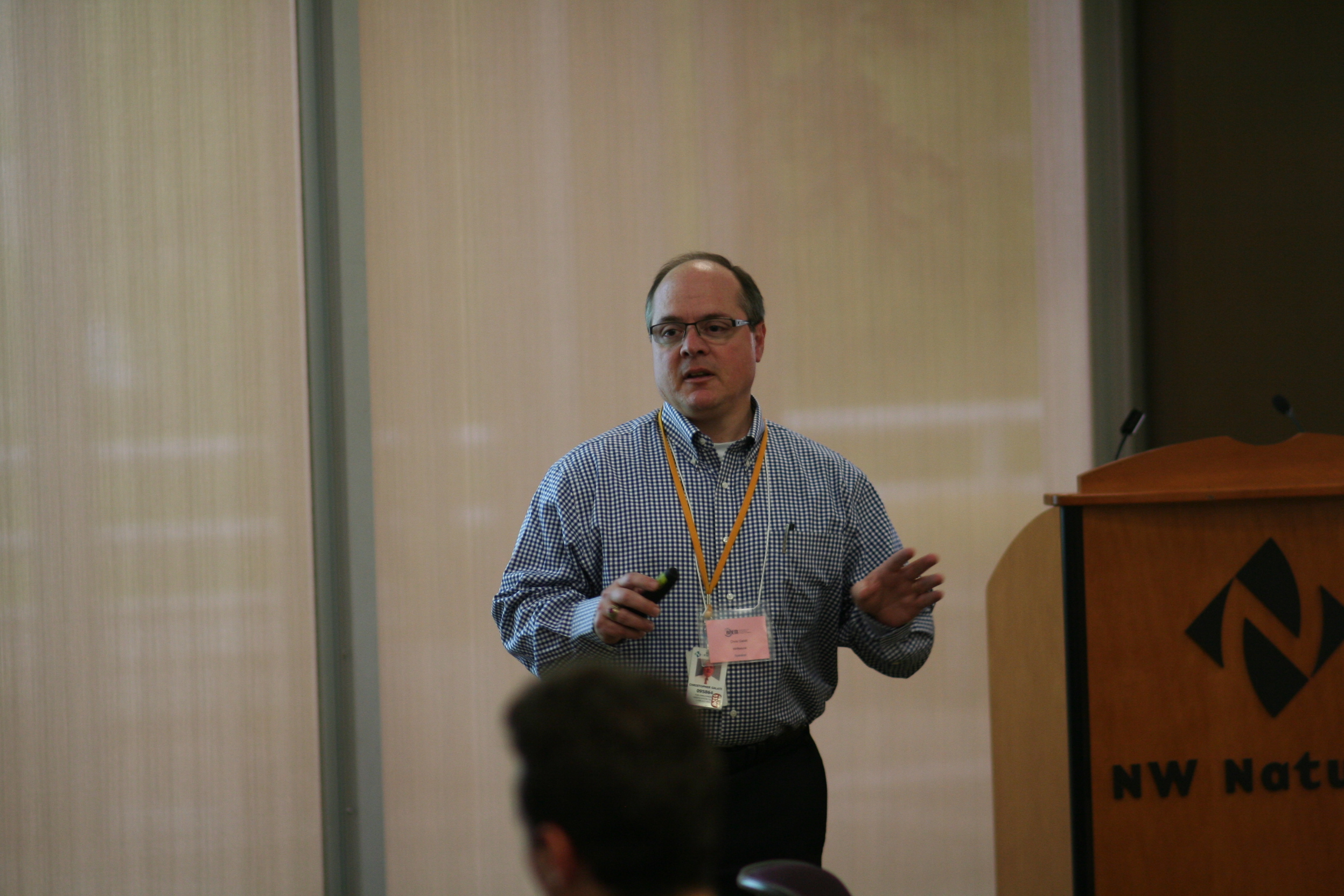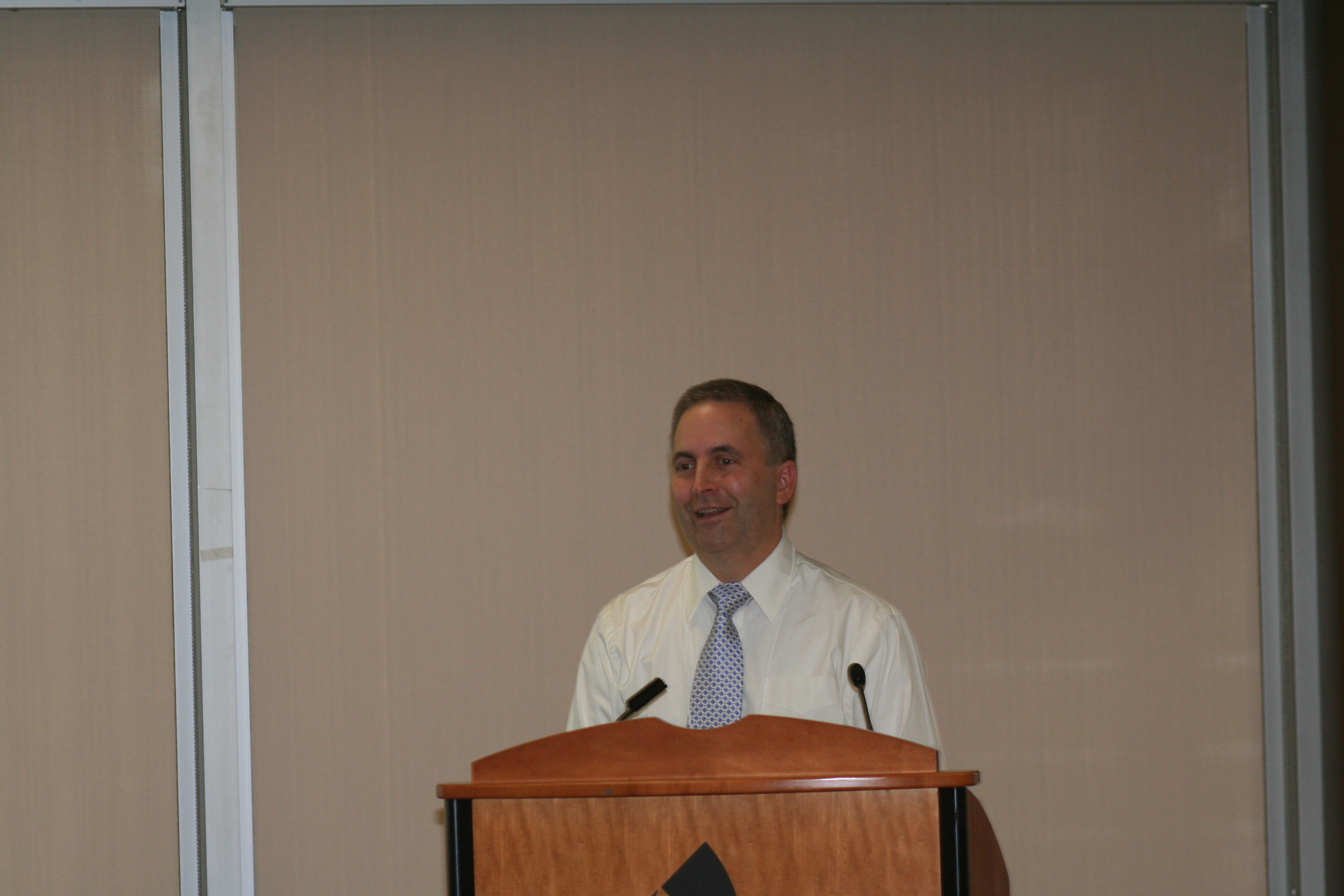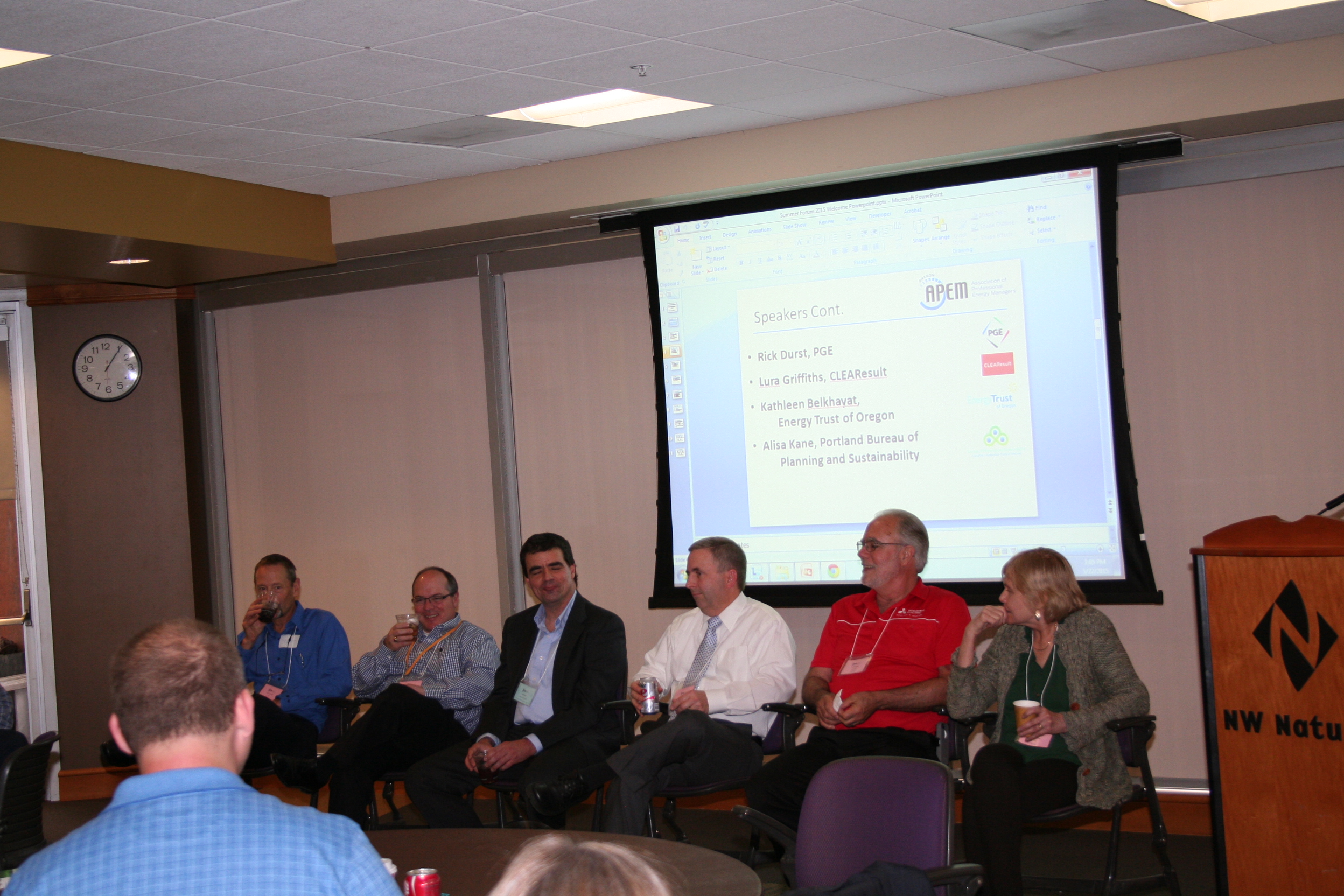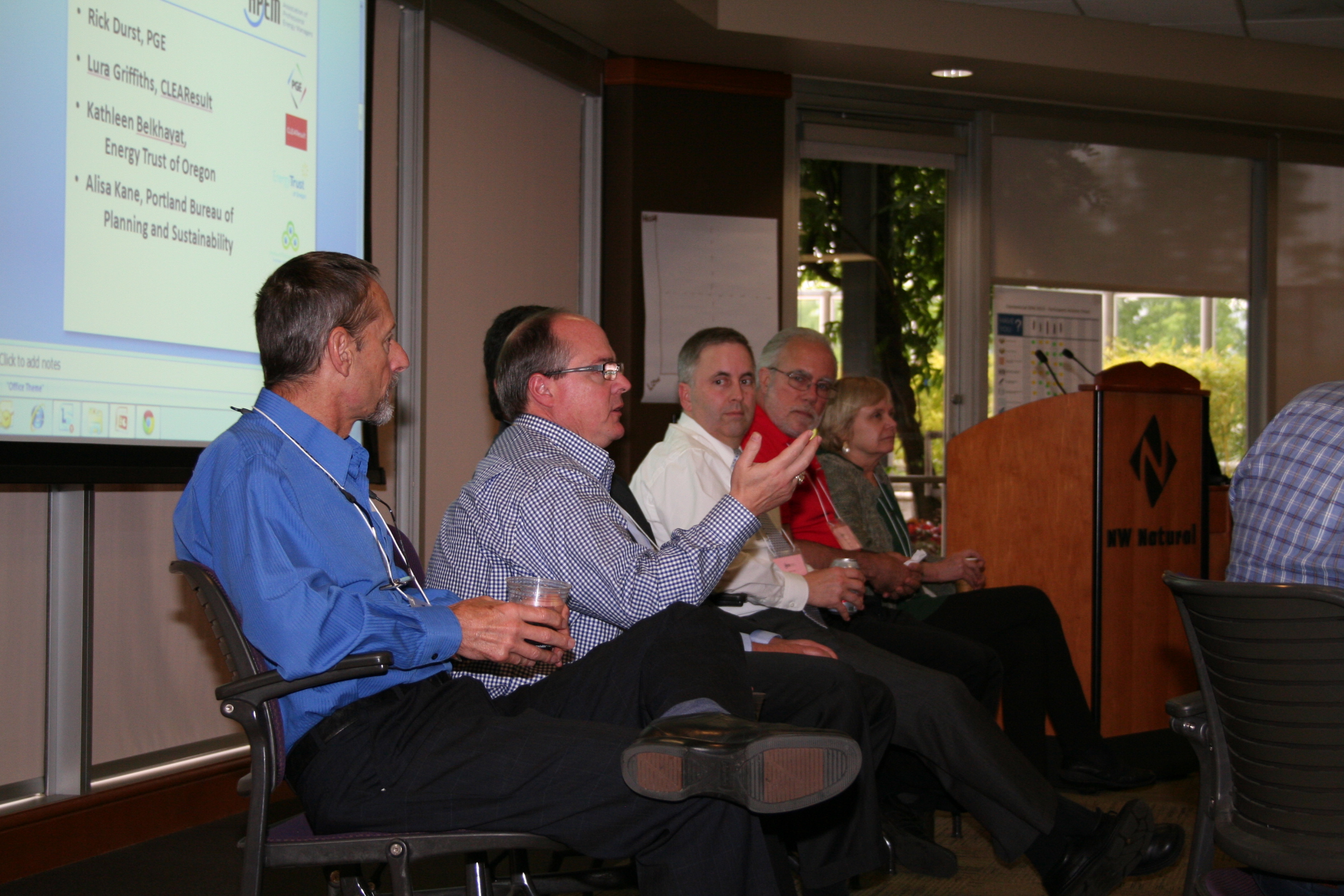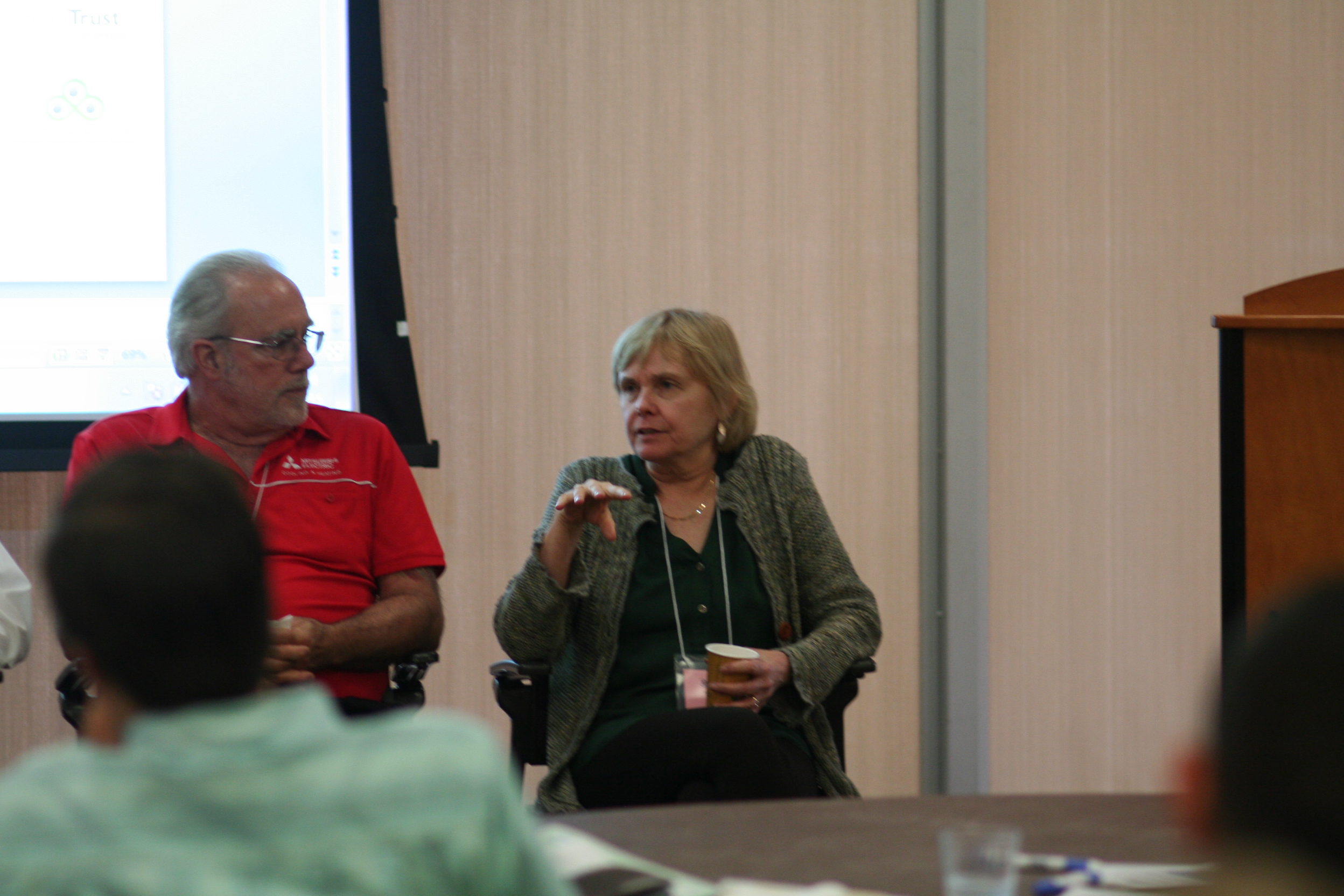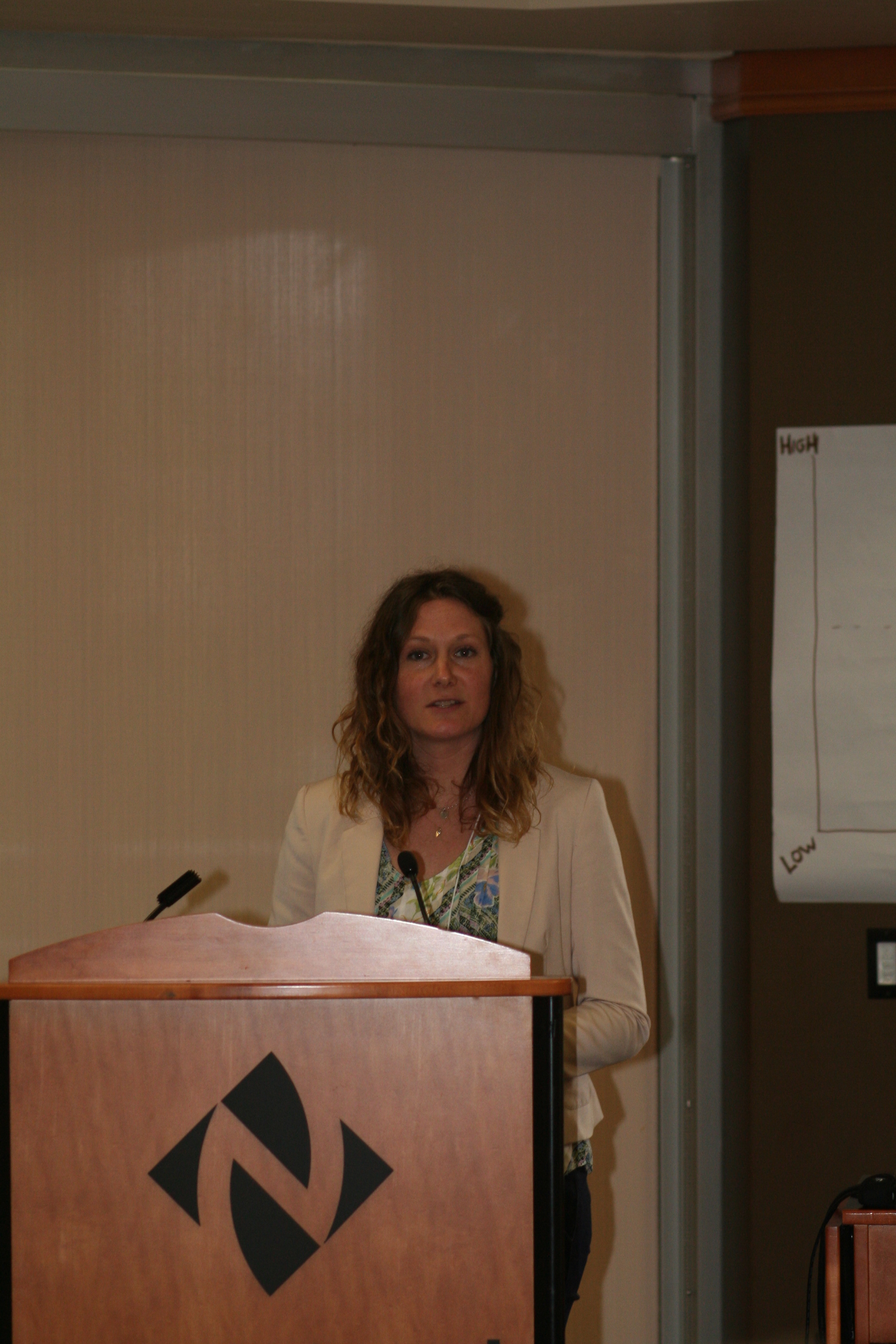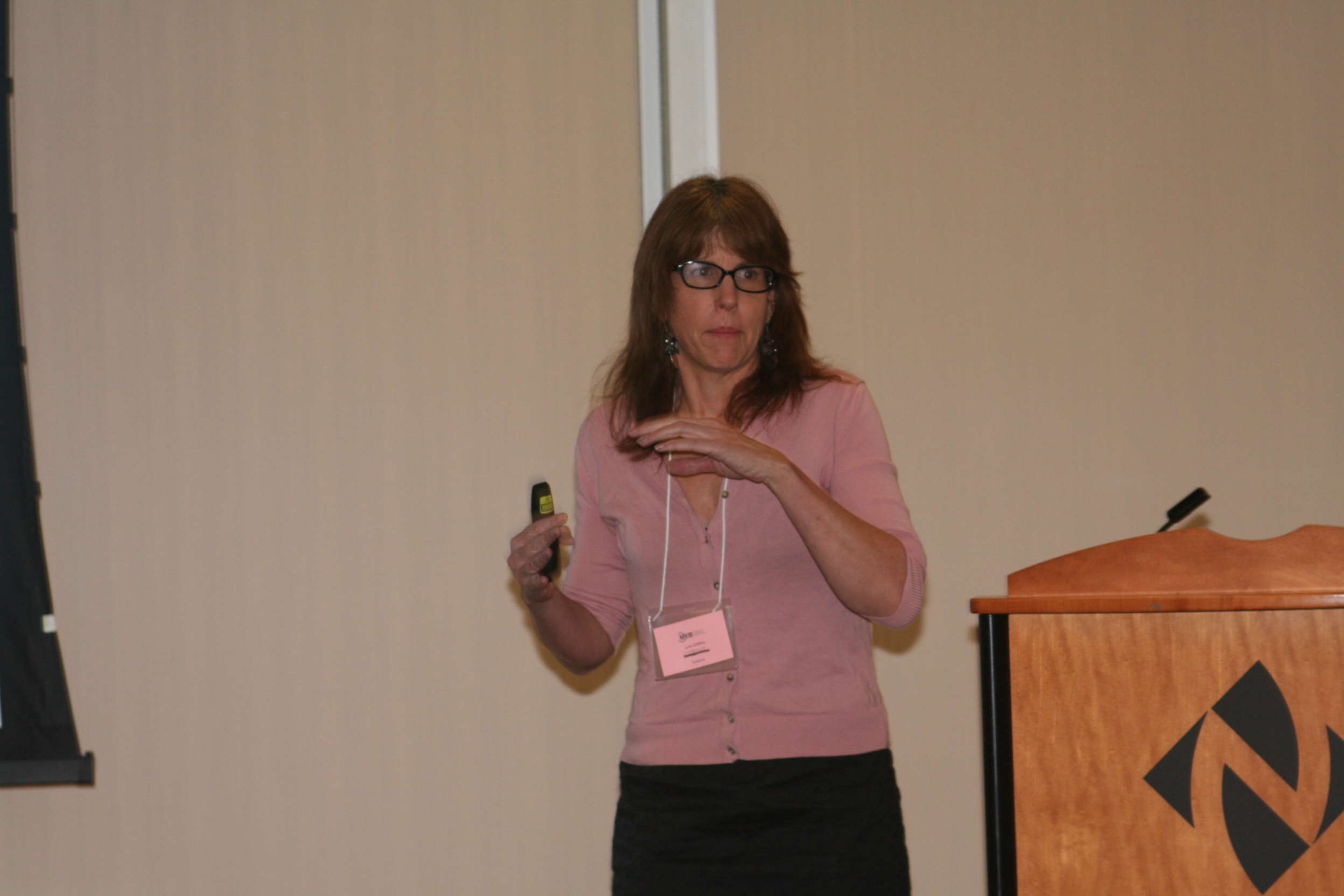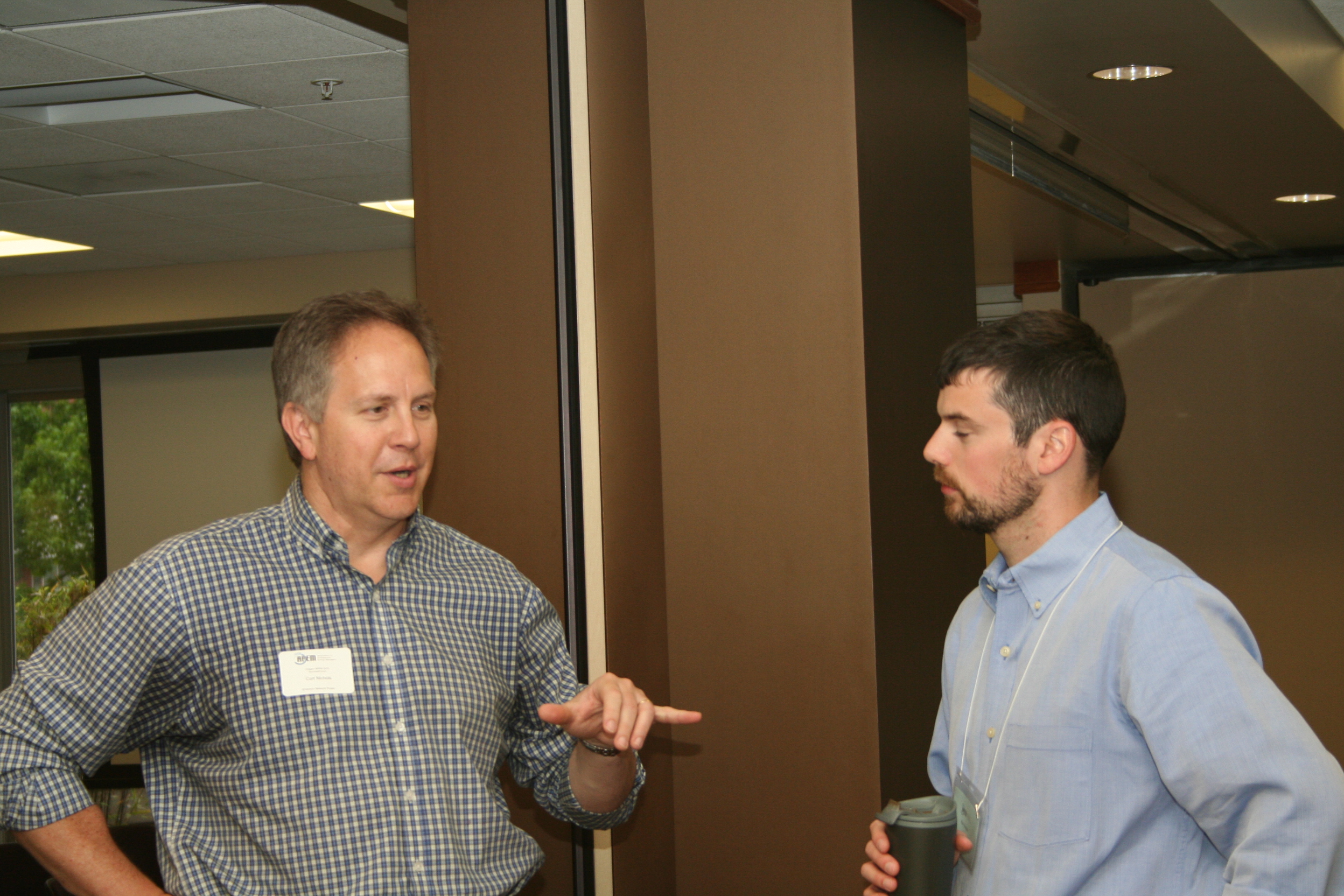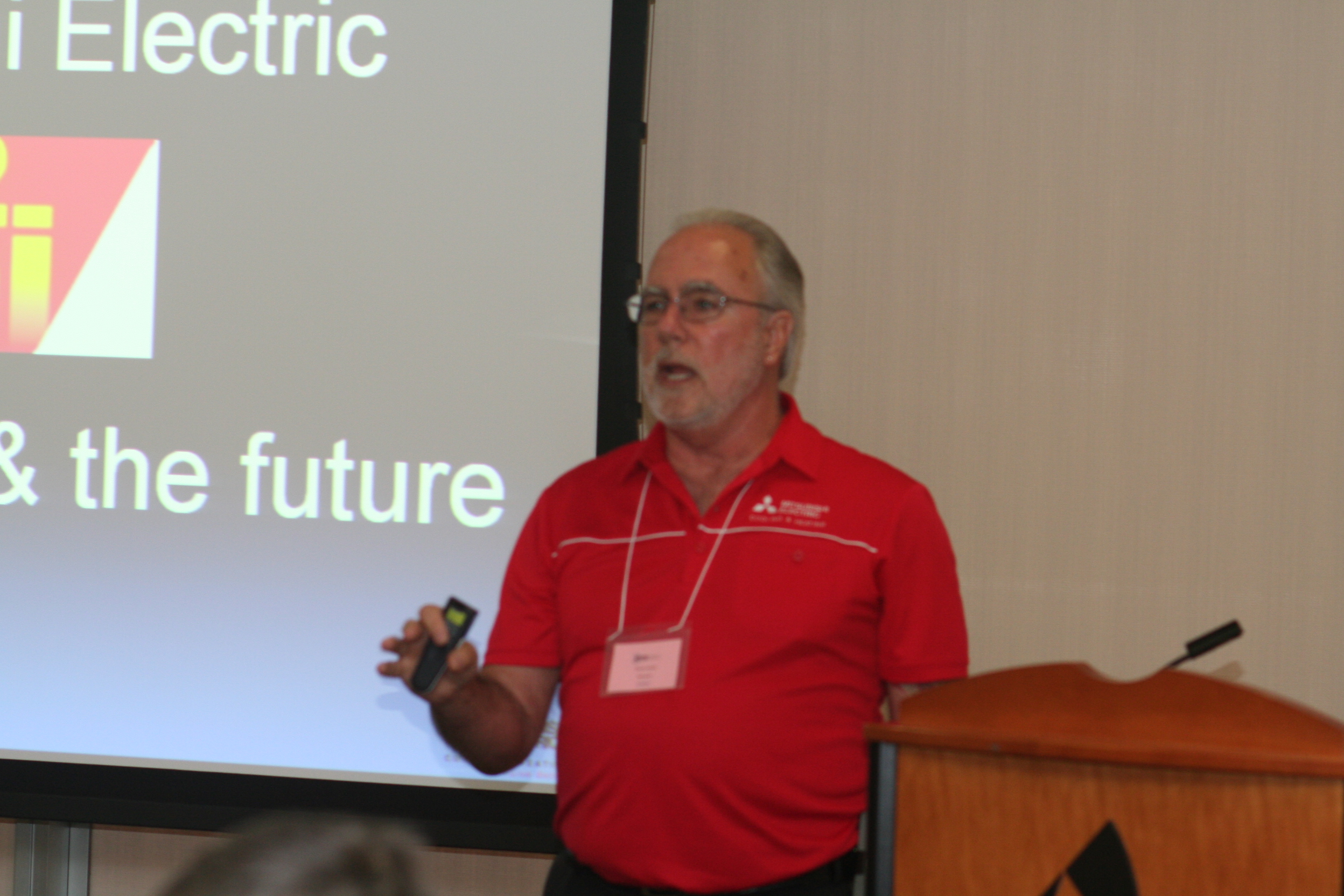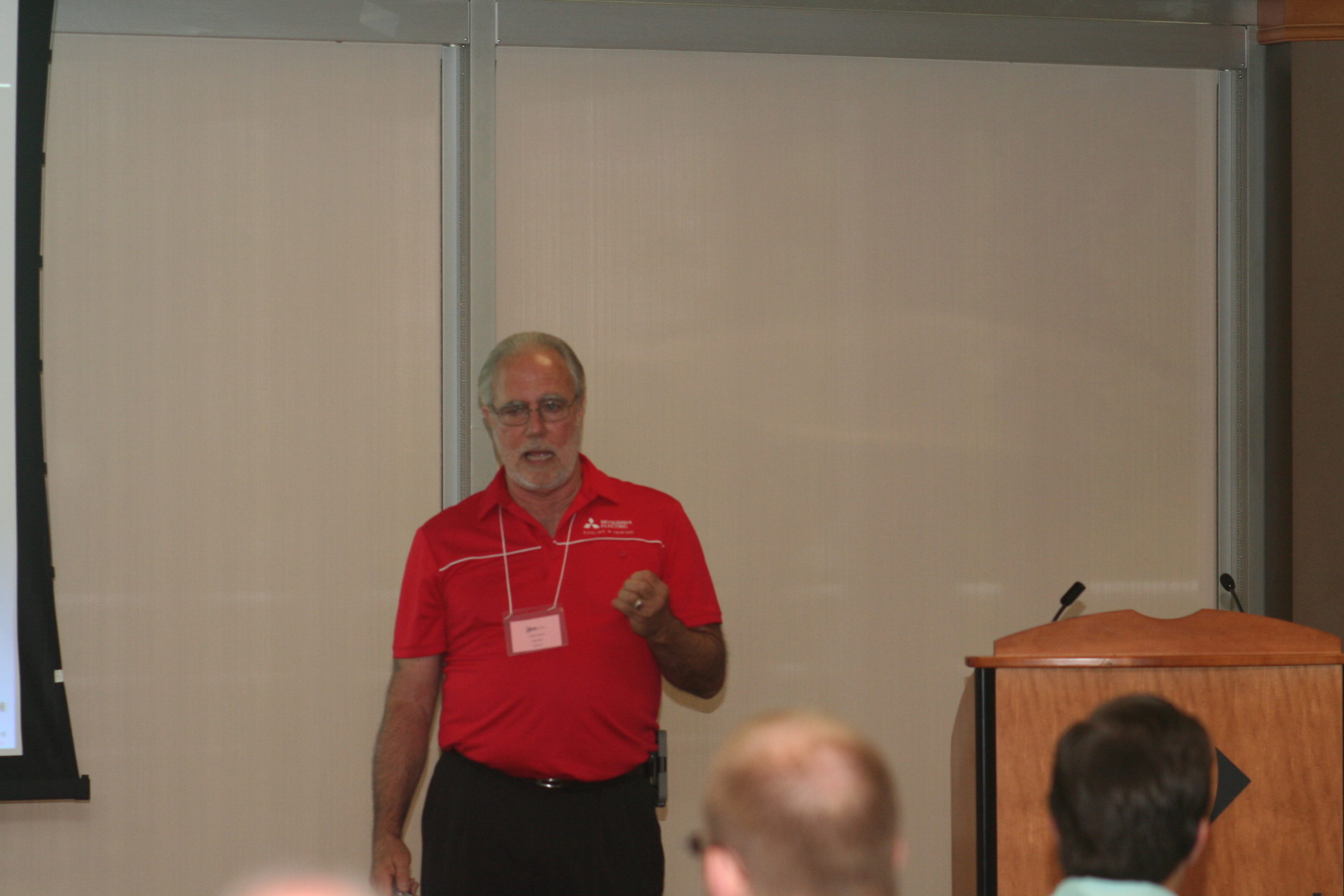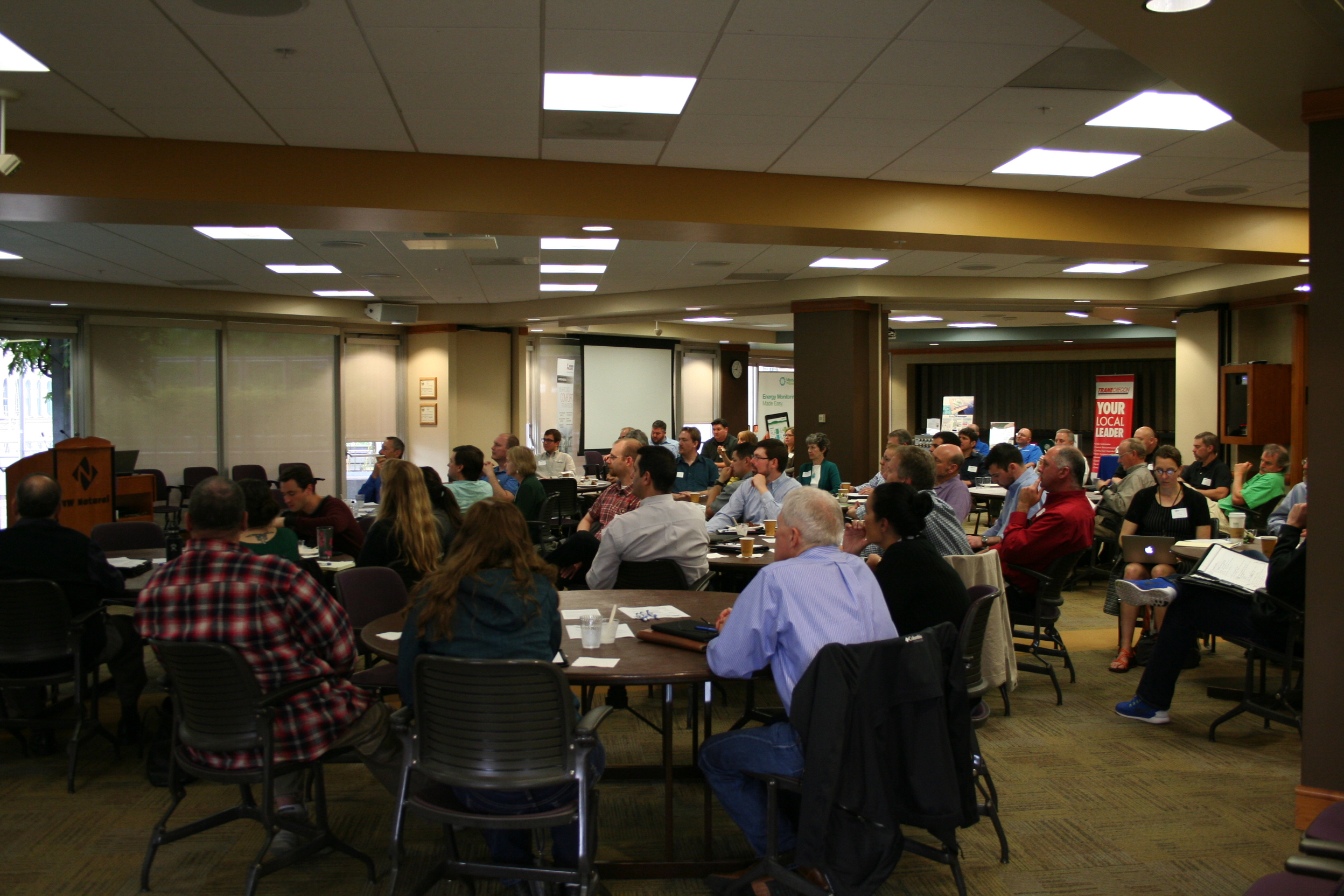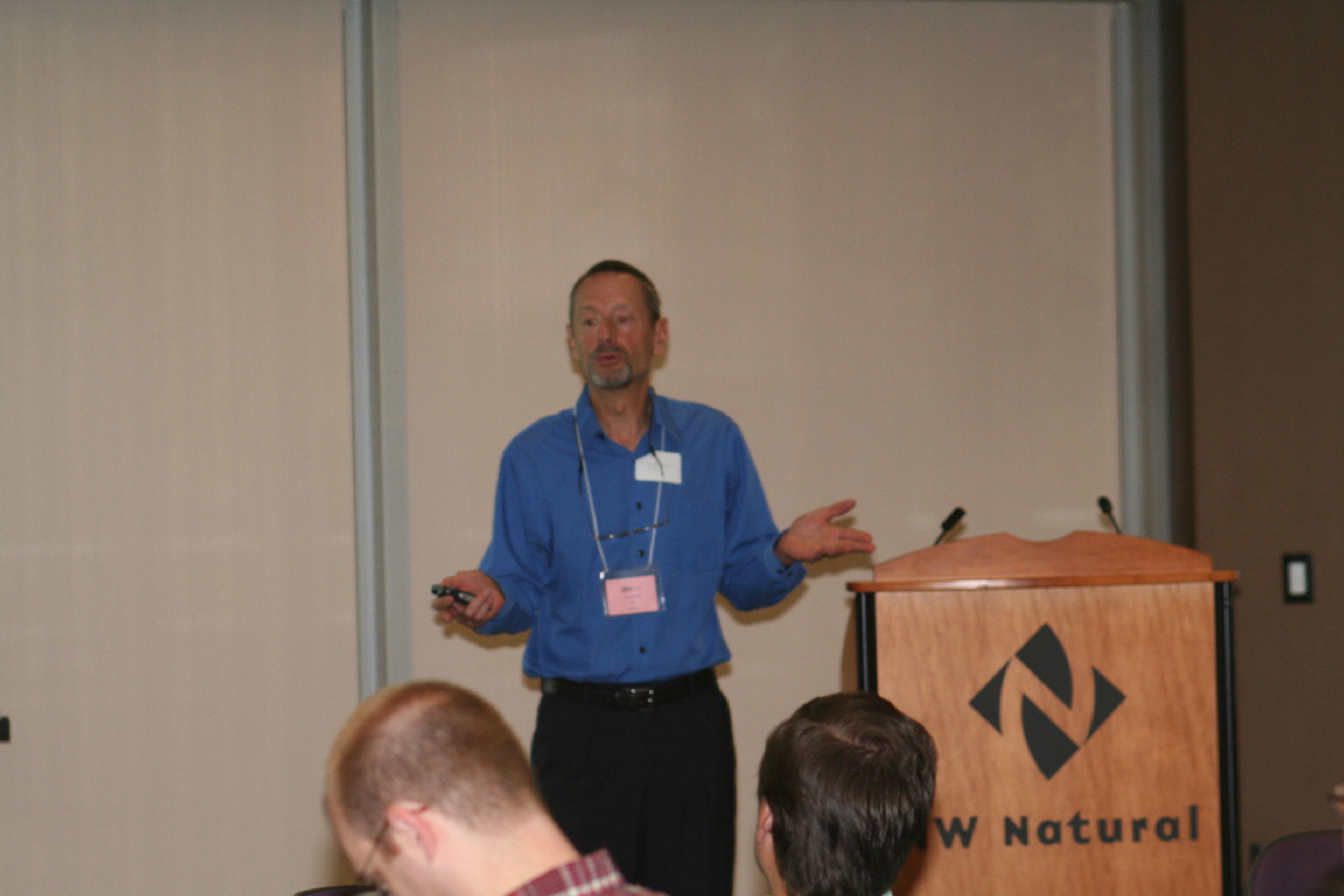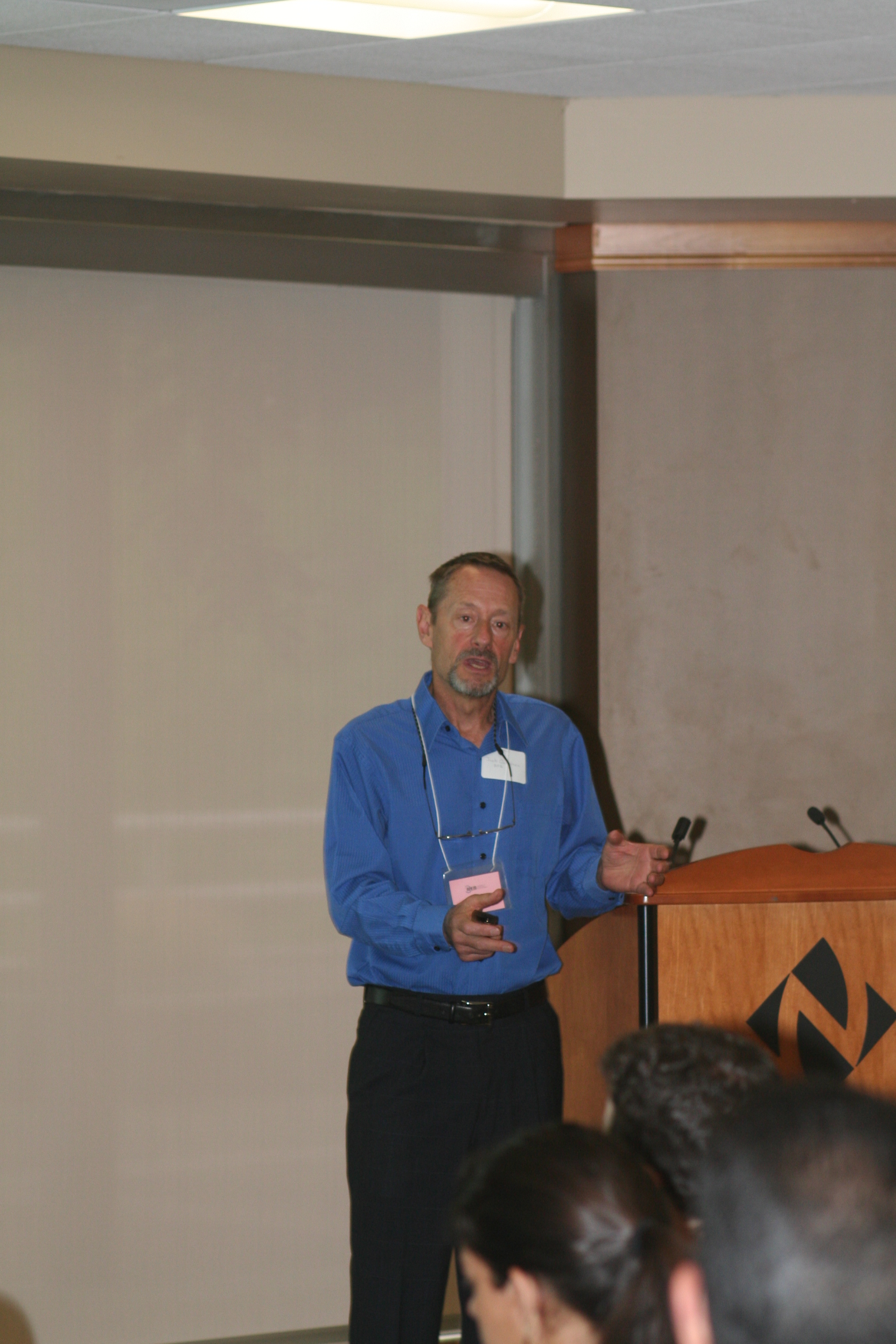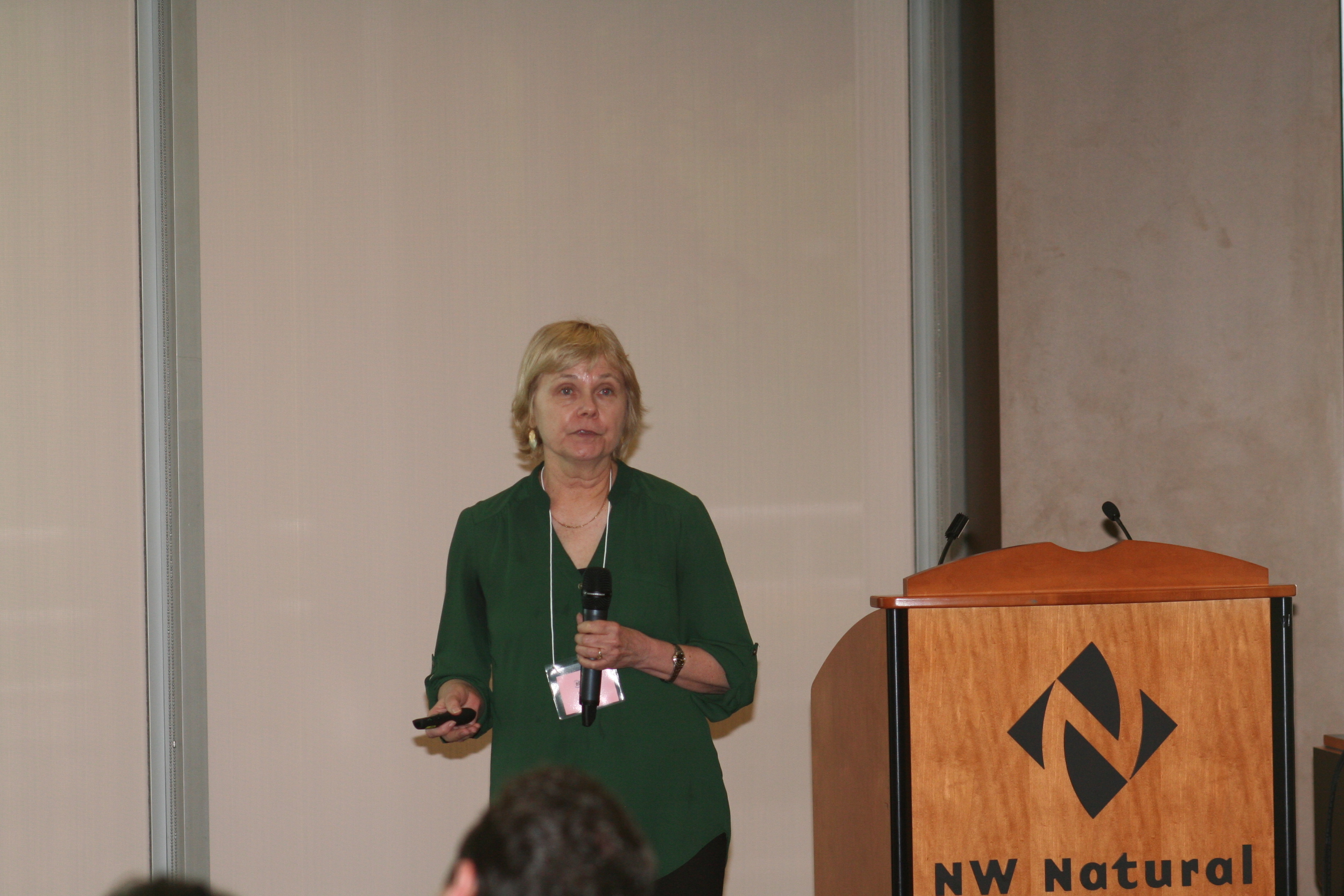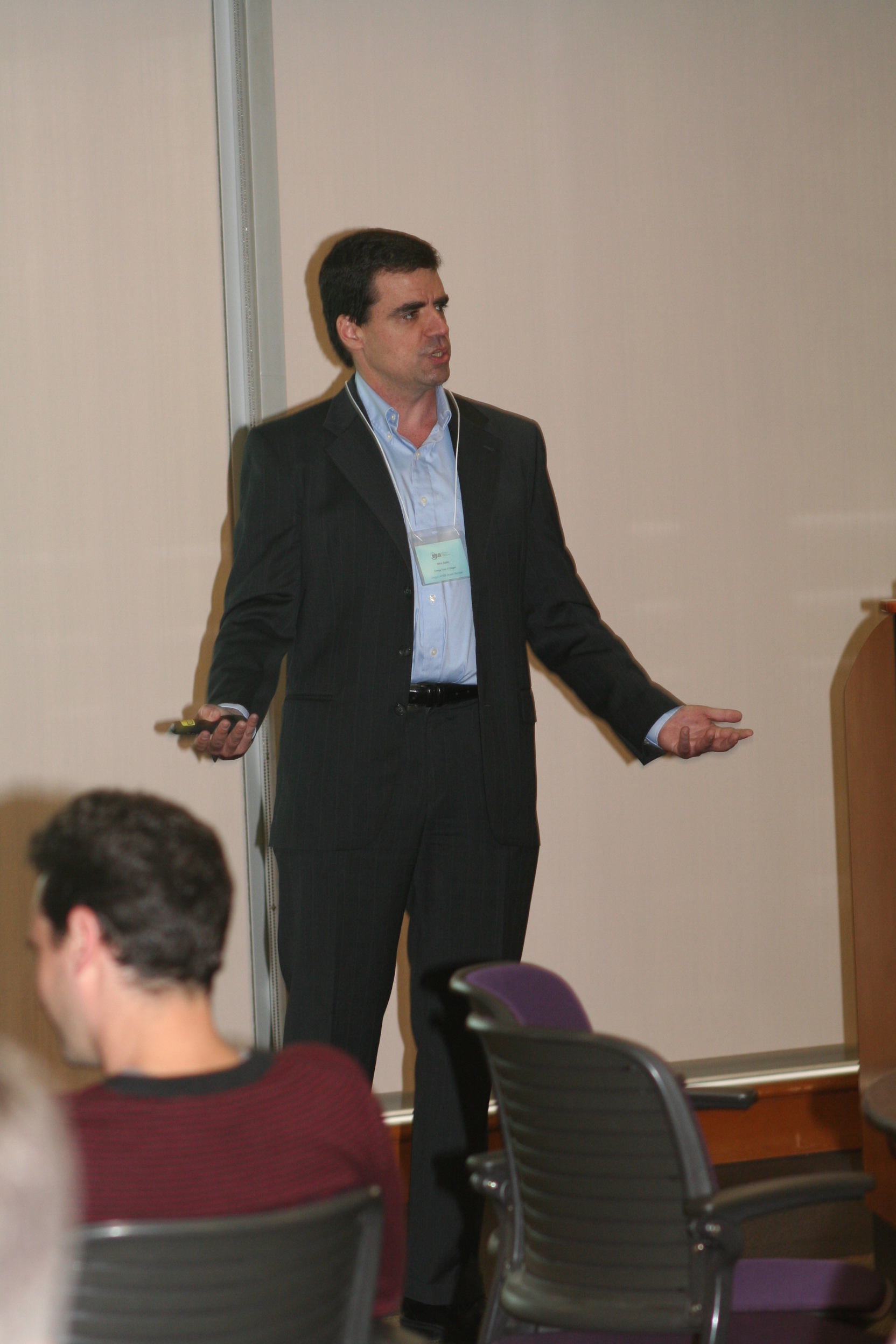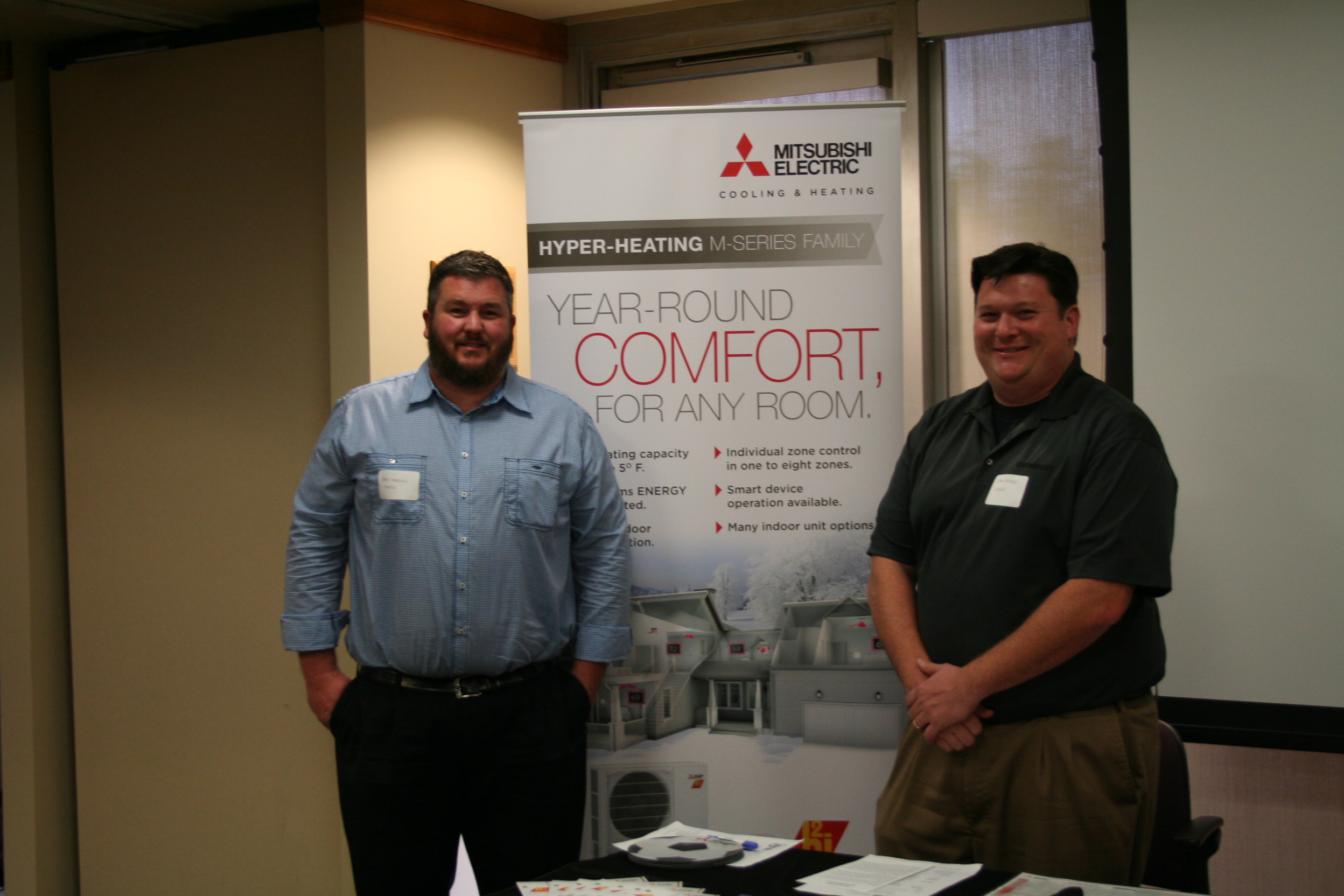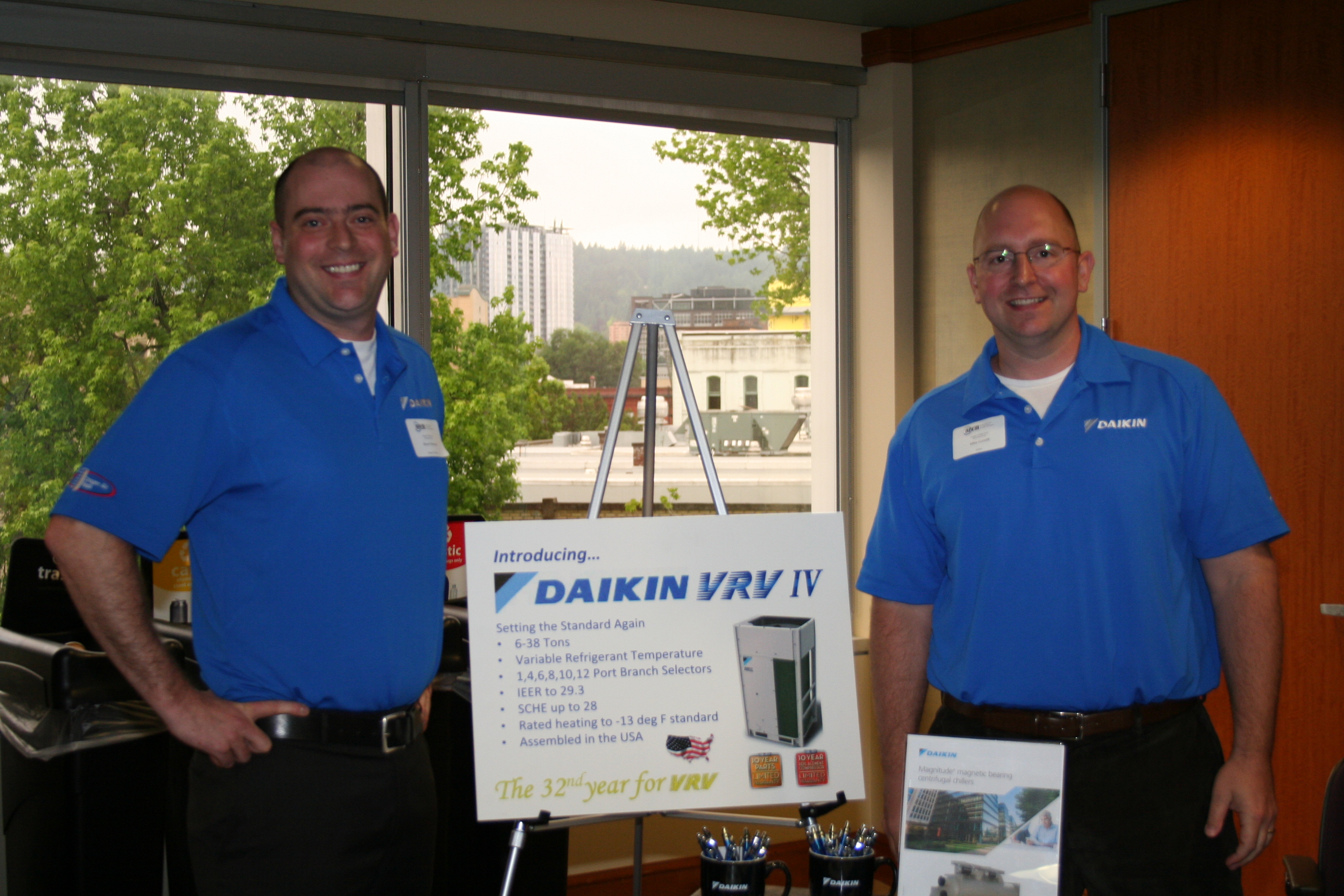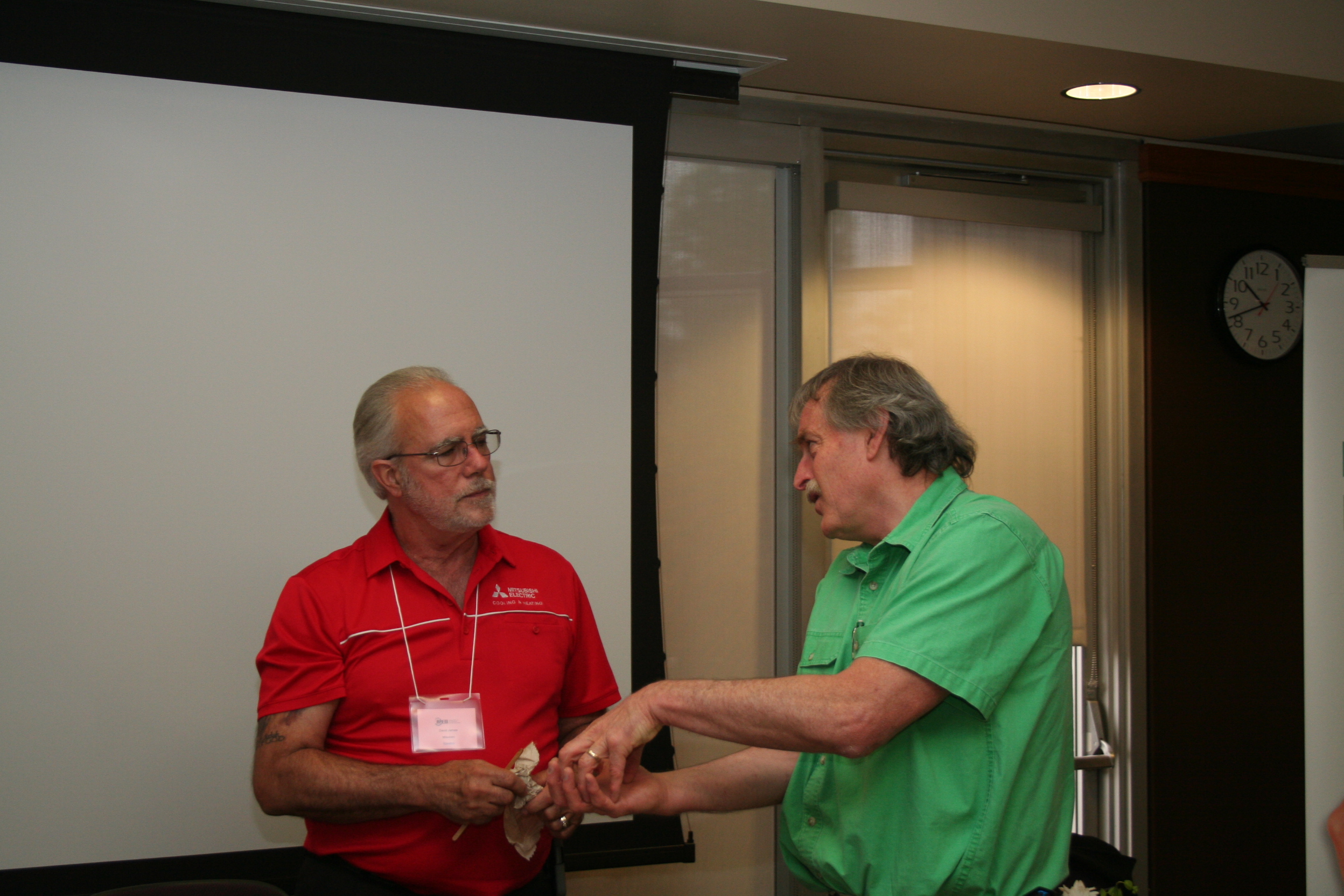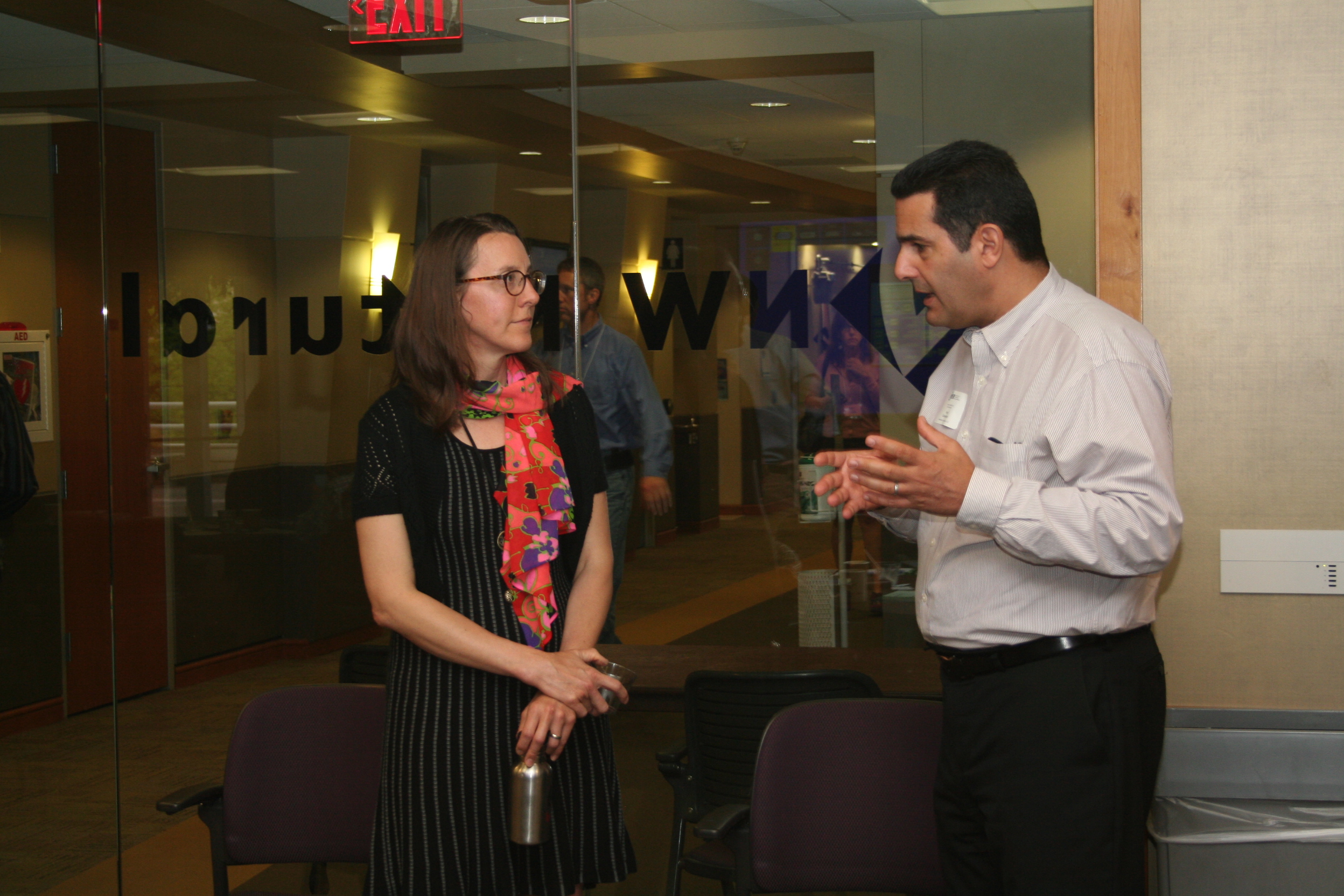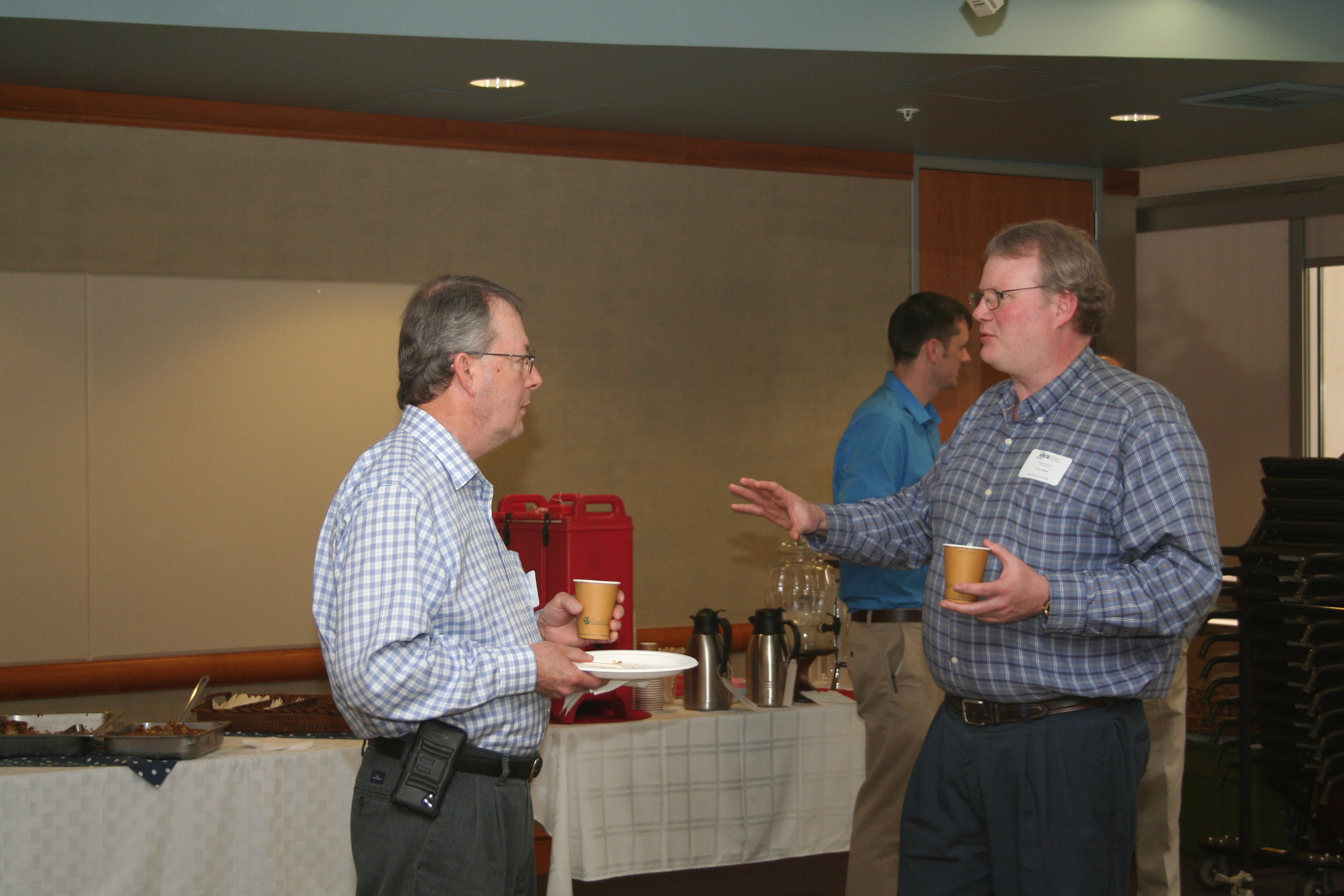Summer 2015 Forum
Emerging Technologies
May 22, 2015
NW Natural Building, Portland
David James, technical sales, Mitsubishi
David discussed Mitsubishi heat pumps’ new HyperHeat® capability, noting that the hard part for heat pumps is the recovery to get back to temperature in heating mode. Mechanically the Hyper-Heat function evaporator coil injects waste heat back into the compressor, making it more efficient and more able to make up the temperature without extra power consumption, and without the need to switch to electric resistance. The boiling refrigerant acts like a next-generation gas bypass, and the compressor speed is regulated. It boasts 100% capacity down to 5 degrees. It provides virtually twice the output in heat mode vs. a similar sized conventional unit, so there is no need to increase size of unit capacity above what would normally be sized for a space. Designed to be installed either as stand-alone air handlers or multi-zone single head units, it is compatible with residential or with small commercial/institutional. Mitsubishi’s version is compatible with off-the-shelf thermostats. The brand also offers connectivity to heat pump water tank heating.
Jack Callahan, Sr Engineer, Research and Development, Bonneville Power Association
Jack discussed upcoming trends in heat pump technology.
1. Heat Pump Research and Development Update: Most manufacturers—many of them Japanese—think globally for all markets, so technologies vary. Japanese manufacturers yearn to understand the US and European markets. Some burgeoning technologies coming from Japan include:
a. Inverter driven heat pumps
b. Low Global Warming Potential (GWP) refrigerants
c. Transcritical CO2 cycle heat pump water heaters
d. Hybrid systems
e. Continued innovation
2. EPRI Update: Residential Ducted Variable Capacity Heat Pump. Capacity at low temperature is very important, especially with the potential to avoid electric resistance strip heat back up. Instead of selling on a SEER (cooling capacity) rating, manufacturers want to demonstrate comparison performance of new technologies to legacy technology performance (field test results). This includes combination multifunction demand response heat pump/water heater technologies.
See: www.E3TNW.org
Janice Peterson, Mechanical Engineer, E3T, BPA contractor (ACS)
Split System CO2 Heat Pump Water Heating – is it a good fit for the NW?
Janice discussed new heat pump technologies. CO2-based refrigerant, known as R744, has a global warming potential (GWP) rating of 1, vs 6-7 for most legacy technologies. CO2 refrigerant cycle heat pumps operate with the refrigerant at very high temperature and pressure—just below phase change-- to allow the fluid to permeate like a gas but keep the absorptive properties of a liquid. Right now the water tanks are slightly taller than traditional water heater tanks. Field tests show that even at cold temperatures the outside compressor unit was only operating 25% of the time to keep the water hot. With leftover capacity the potential exists to use downtime for space heating, which could include hydronic underfloor. 55% of NW households use electric resistance heat, so there is great market potential.
BPA has three current research projects involving new heat pump technology:
1. Performances as a water heater
2. Demand-response potential
3. Combination space and water heating.
Mike Bailey, ME, Engineering Manager, Energy Trust of Oregon
Variable Refrigerant Flow (VRF) and “ClimaCheck” for optimizing chiller performance
Mike explained the mechanics of VRF. Knowing that there is no such thing as a “magic bullet” that will solve energy efficiency, one viable technology that is emergent and still emerging is Variable Refrigerant Flow for heat pumps. VRF allows buildings to meet the simultaneous cooling and heating loads that exist in different areas of a building. It is more efficient to separate the HVAC component that provides the outside air requirement from the component that maintains temperature and humidity. A benefit is that the heating system can recover the interior heat and reuse it rather than constantly reheat pre-cooled outside air. In high density metropolises like Europe and Japan, heat pump technology has been used for years as a space saving technology in addition to EE. Installation may require other trades, like plumbers unions, rather than traditional HVAC installers. What is tough for building operators is that in the U.S., unlike other nations, we have no performance standard. Once a unit is installed, there is no performance monitoring regulation.
ClimaCheck is a refrigeration/chiller system diagnostics tool from Sweden, similar to EMS, but much more specific to chillers. Its benefit is that it can really be dialed in to one of the most expensive-to-operate components of HVAC. Drawbacks are that it takes many more submeters installed to record data, and that there are very few professionals trained to successfully read and interpret the data fluently enough to propose system improvements.
Chris Galati, NW Natural (and former APEM Board member)
Carbon Solutions: Senate Bill 844 allows natural gas utilities to voluntarily develop greenhouse gas reduction projects. Projects must have greenhouse gas reductions, and measures that provide results above existing programs. NWN has begun a 10-yr pilot program with different projects. Examples are anaerobic digesters for biogas, and CHP (co-gen) projects.
Cogeneration is not as popular in Oregon because the power costs are so low that project payback is longer than most consumers’ appetite. Typical candidates are consumers with consistent 24/7 power and heating (gas) loads, like hospitals, some grocery, etc. 1MW – 4MW load at $30/metric ton of carbon is a best case scenario size for a CHP turbine.
Methane abatement, oil recovery, and natural gas vehicles are other programs.
NWN natural is hedging that index prices can be tied to SB844, meaning that when gas prices go down, carbon prices go up, and vice versa.
Rick Durst, Innovative Technologies, Portland General Electric
New innovative energy/grid projects to improve reliability
Rick discussed trends in the power utility:
Smart Grid: improved system visibility in order to improve reliability, including proactive measures to maintain systems to keep the power on.
Smart Power Project: a 5MW backup battery for the grid. A successful live event took place Feb 22, 2015, where the battery system was used to back up a region of PGE’s distribution system which went down due to weather. No customers were adversely impacted thanks to Smart Power back up.
Software to monitor energy is available online for residential and small commercial; and there is subscription-based EMS (PGE’s Energy Expert) for large commercial.
Automated Demand Response is a voluntary reduction program that pays customers for voluntary curtailment.
Electric Vehicles: 19 models available in Oregon. All are good performers. Consumers need to be aware of charging capabilities, and local infrastructure (charging stations).
All Presenters
Panel discussion included audience questions answered by presenters: effect of global warming on refrigerant development, trends in EV charging stations, cost to consumers for mainstream CO2 heat pump hot water heaters, preferred temperature of stored water heater water, natural heat resource connectivity to combination heat pumps, TOU metering for solar and EV, viability of strategy development in the future.
Laura Griffiths, Strategic Energy Management, Triple Point Energy
Kathleen Belkhyat, Commercial Strategic Energy Management Team, Energy Trust
The Energy Trust’s Strategic Energy Management (SEM) encourages behavioral changes to effect low-cost/no-cost EE measures. It takes extra planning, and a reporting / follow-up system to track performance. It takes more than an army of one—each department should have a leader who is a member of the team and reports to the energy manager. ETO offers workshops, building opportunity assessments, action plans and policy development assistance, and benchmarking. Typical savings is 4%-8% of energy costs.
Email: CommercialSEM@Energytrust.org
Alisa Kane, Energy Performance Reporting Program, Portland Bureau of Planning and Sustainability
Many consumer products have ratings or product scoring for consumers to review (like food labels), but buildings often don’t. $338.6M is spent annually on energy by commercial buildings in Portland, and ¼ of carbon emissions are from commercial buildings. Buildings that consistently track their own performance save 2.4% per year in energy costs. City of Portland is now requiring commercial buildings of certain sizes to phase-in to its measurement program, and will score participants. There will be financial penalties for not reporting.
www.portlandoregon.gov/bps/energyreporting
APEM Board Member Dave Cone received recognition citation for exceptional energy efficiency in Evergreen school district’s improvements.
Presentations:


